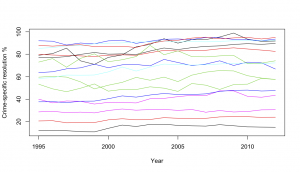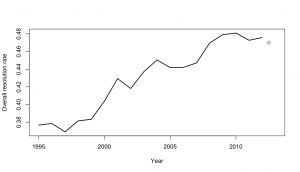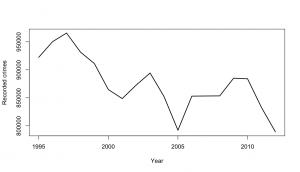Crime news vs crime data
If you actually look at the data, neither the Herald nor Stuff comes off well in today’s crime figure reports. Stuff has the headline “Crime drop due to ‘tag and release'”, and it’s not until the third paragraph that they admit the ‘tag and release’ impact is on court workloads and has nothing to do with number of crimes reported. The Herald says
Crime is at its lowest level in 24 years but the percentage of offences that police solve is also dropping – less than half of all cases.
This is at least technically true, but the drop they are talking about is less than one percentage point, when the resolution rate differs between types of crime by about 90 percentage points. Even a small change in the relative numbers of different offenses would make a one percentage difference in overall resolution rate meaningless. Here, using data from Stats New Zealand are the resolution rates for 16 categories of crime over the past 18 years.
I haven’t tried to label them all, but at the top are homicides, acts intended to cause injury, illegal drug offenses, and offenses against justice procedures and government operations. The reasons vary: the resolution rate for violent crimes is high because police put a lot of effort into solving them; the rate is high for drug offenses because they aren’t usually reported except when the police discover them. At the low end are burglary and unlawful entry, where the vast majority of cases are never resolved. If anyone is trying to sell you a policy based on a small change in the average of these, without accounting for variation in proportions, you should keep a firm grip on your wallet.
Against that background, what does the trend in resolution rate look like?
The lines show the past 18 fiscal years, the dot shows todays data for the 2012 calendar year. It’s possible that the resolution rate is flattening out at its peak of 48%, or even decreasing slowly over the past few years, but it’s hardly convincing evidence of a trend.
The change in recorded crimes over time is also a fairly noisy trend, but generally downwards even before we account for population growth
It’s also worth pointing out that preventing crime is important, but catching criminals is beneficial primarily as a means of preventing crime. A low crime rate with few crimes resolved is far preferable to a high crime rate with most crimes resolved. The easiest way for the police to increase the resolution rate would be to put more effort into catching drug users, but it would be hard to regard that as the most socially useful way to spend their time and taxpayers money.
Thomas Lumley (@tslumley) is Professor of Biostatistics at the University of Auckland. His research interests include semiparametric models, survey sampling, statistical computing, foundations of statistics, and whatever methodological problems his medical collaborators come up with. He also blogs at Biased and Inefficient See all posts by Thomas Lumley »



And note further that “Tag and release” is EFFECTIVE!
http://www.jstor.org/stable/10.1086/669786
12 years ago
Scratch my prior comment. Tag and release, as I understood it, was releasing prisoners with electronic monitoring devices. I have no evidence on the pre-trial warning system.
12 years ago